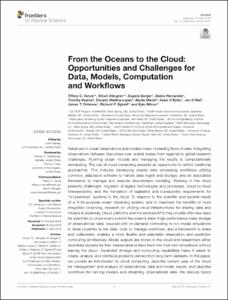| dc.contributor.author | Vance, T.C. | |
| dc.contributor.author | Wengren, M. | |
| dc.contributor.author | Burger, E. | |
| dc.contributor.author | Hernandez, D. | |
| dc.contributor.author | Kearns, T. | |
| dc.contributor.author | Medina-Lopez, E. | |
| dc.contributor.author | Merati, N. | |
| dc.contributor.author | O’Brien, K. | |
| dc.contributor.author | O’Neil, J. | |
| dc.contributor.author | Potemra, J.T. | |
| dc.contributor.author | Signell, R.P. | |
| dc.contributor.author | Wilcox, K. | |
| dc.date.accessioned | 2021-08-19T20:20:33Z | |
| dc.date.available | 2021-08-19T20:20:33Z | |
| dc.date.issued | 2019 | |
| dc.identifier.citation | Vance, T.C., Wengren, M., Burger, E.,
Hernandez, D., Kearns, T.,
Medina-Lopez, E., et al (2019) From the Oceans
to the Cloud: Opportunities
and Challenges for Data, Models,
Computation and Workflows.
Frontiers in Marine Science, 6:211, 18pp.
DOI 10.3389/fmars.2019.00211 | en_US |
| dc.identifier.uri | https://repository.oceanbestpractices.org/handle/11329/1710 | |
| dc.identifier.uri | http://dx.doi.org/10.25607/OBP-1640 | |
| dc.description.abstract | Advances in ocean observations and models mean increasing flows of data. Integrating
observations between disciplines over spatial scales from regional to global presents
challenges. Running ocean models and managing the results is computationally
demanding. The rise of cloud computing presents an opportunity to rethink traditional
approaches. This includes developing shared data processing workflows utilizing
common, adaptable software to handle data ingest and storage, and an associated
framework to manage and execute downstream modeling. Working in the cloud
presents challenges: migration of legacy technologies and processes, cloud-to-cloud
interoperability, and the translation of legislative and bureaucratic requirements for
“on-premises” systems to the cloud. To respond to the scientific and societal needs
of a fit-for-purpose ocean observing system, and to maximize the benefits of more
integrated observing, research on utilizing cloud infrastructures for sharing data and
models is underway. Cloud platforms and the services/APIs they provide offer new ways
for scientists to observe and predict the ocean’s state. High-performance mass storage
of observational data, coupled with on-demand computing to run model simulations
in close proximity to the data, tools to manage workflows, and a framework to share
and collaborate, enables a more flexible and adaptable observation and prediction
computing architecture. Model outputs are stored in the cloud and researchers either
download subsets for their interest/area or feed them into their own simulations without
leaving the cloud. Expanded storage and computing capabilities make it easier to
create, analyze, and distribute products derived from long-term datasets. In this paper,
we provide an introduction to cloud computing, describe current uses of the cloud
for management and analysis of observational data and model results, and describe
workflows for running models and streaming observational data. We discuss topics
that must be considered when moving to the cloud: costs, security, and organizational
limitations on cloud use. Future uses of the cloud via computational sandboxes and
the practicalities and considerations of using the cloud to archive data are explored.
We also consider the ways in which the human elements of ocean observations are
changing – the rise of a generation of researchers whose observations are likely to be
made remotely rather than hands on – and how their expectations and needs drive
research towards the cloud. In conclusion, visions of a future where cloud computing is
ubiquitous are discussed. | en_US |
| dc.language.iso | en | en_US |
| dc.rights | Attribution 4.0 | * |
| dc.rights.uri | http://creativecommons.org/licenses/by/4.0/ | * |
| dc.subject.other | Ocean modeling | en_US |
| dc.subject.other | Cloud computing | en_US |
| dc.subject.other | Data archiving | en_US |
| dc.title | From the Oceans to the Cloud: Opportunities and Challenges for Data, Models, Computation and Workflows. | en_US |
| dc.type | Journal Contribution | en_US |
| dc.description.refereed | Refereed | en_US |
| dc.format.pagerange | 18pp. | en_US |
| dc.identifier.doi | 10.3389/fmars.2019.00211 | |
| dc.subject.parameterDiscipline | Cross-discipline | en_US |
| dc.subject.dmProcesses | Data management planning and strategy development | en_US |
| dc.subject.dmProcesses | Data archival/stewardship/curation | en_US |
| dc.bibliographicCitation.title | Frontiers in Marine Science | en_US |
| dc.bibliographicCitation.volume | 6 | en_US |
| dc.bibliographicCitation.issue | Article 211 | en_US |
| dc.description.sdg | 14.a | en_US |
| dc.description.eov | N/A | en_US |
| dc.description.methodologyType | Method | en_US |
| dc.description.methodologyType | Specification of criteria | en_US |
| obps.contact.contactname | Tiffany C. Vance | |
| obps.contact.contactemail | tiffany.c.vance@noaa.gov | |
| obps.resourceurl.publisher | https://www.frontiersin.org/articles/10.3389/fmars.2019.00211/full | |
 Repository of community practices in Ocean Research, Applications and Data/Information Management
Repository of community practices in Ocean Research, Applications and Data/Information Management

